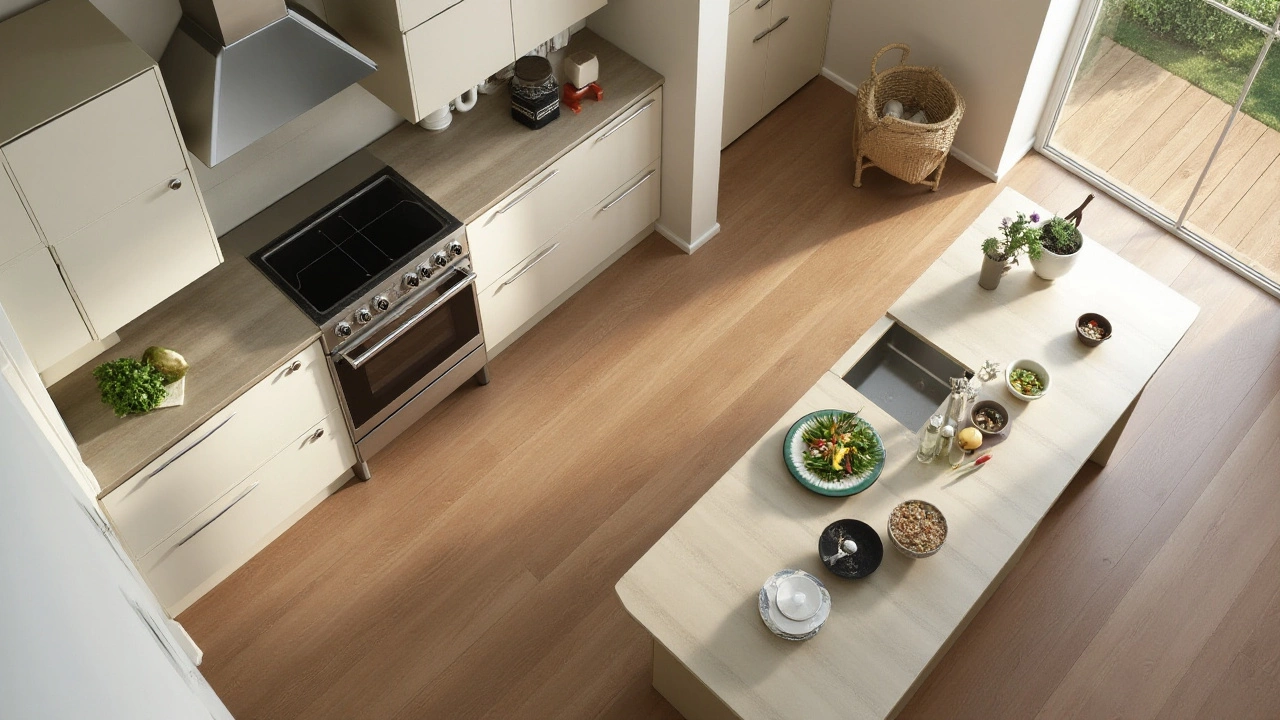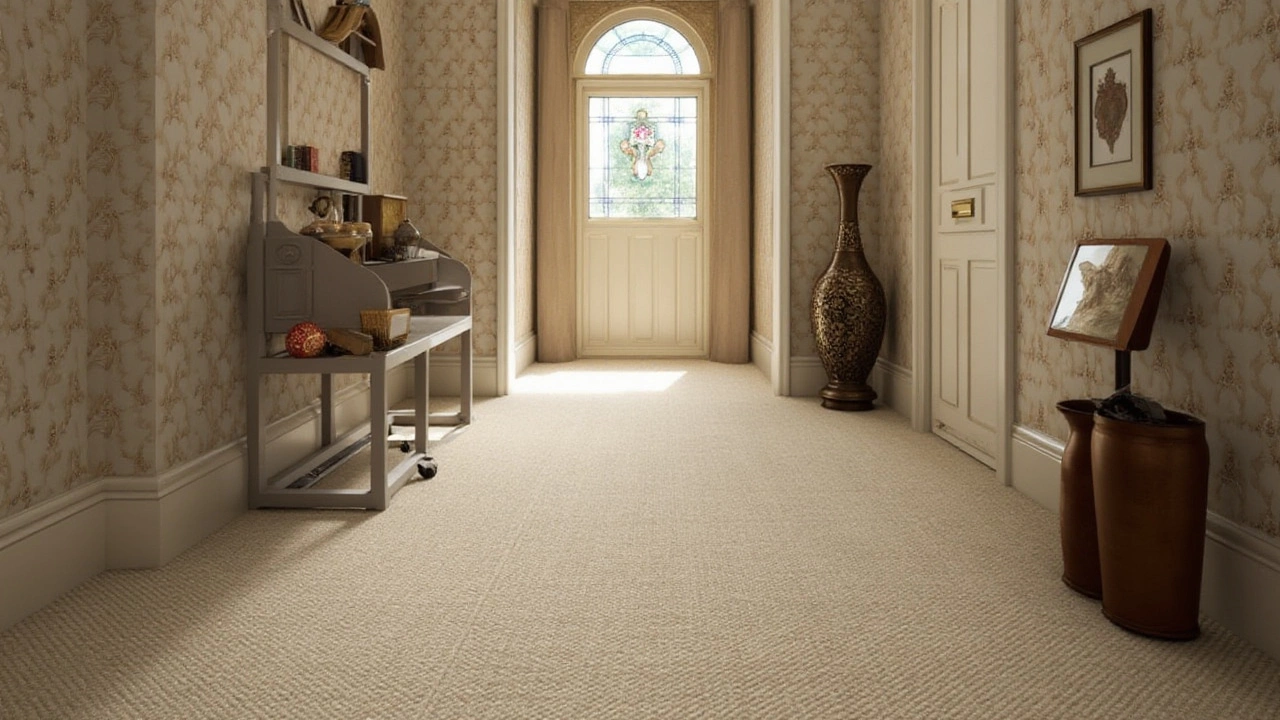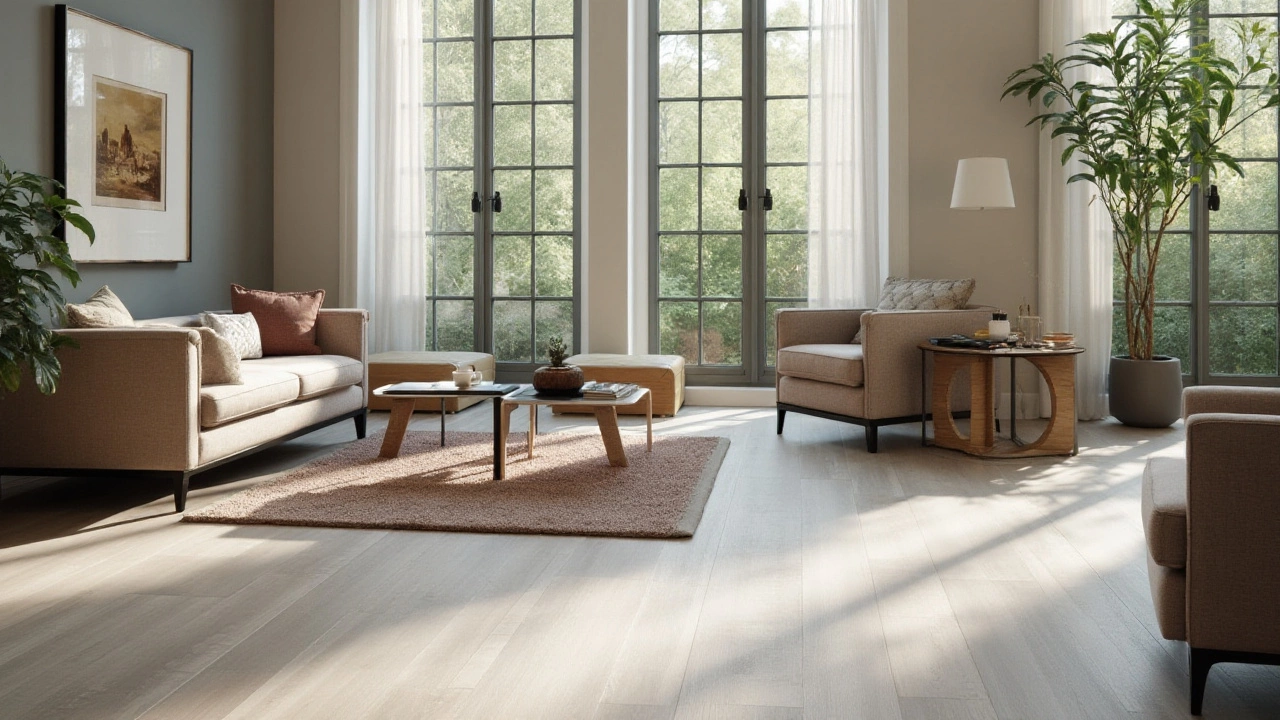Walking into a home, one of the first features that catches a potential buyer's eye is the flooring. Color plays a crucial role in setting the atmosphere and can either enhance or detract from the appeal of a home. So, how do you choose a floor color that not only fits personal tastes but also maximizes resale value?
Neutral tones have long been hailed as the go-to choice for homeowners looking to sell without narrowing their pool of buyers. Subtle shades like grays, light browns, or even soft whites offer a versatile canvas, helping spaces appear larger and more inviting.
While sticking to classics may seem comforting, understanding current trends without sacrificing timeless appeal can bring an added edge. In this read, we navigate through color options that strike a balance between trending and enduring, ensuring your flooring choice boosts potential returns on investment.
- The Role of Flooring Color in Home Resale
- Popular Flooring Colors that Sell
- Trendy vs Timeless: Making the Right Choice
- Impact of Material and Finish on Color Choice
- Expert Tips for Choosing the Perfect Floor Color
The Role of Flooring Color in Home Resale
Choosing the right flooring color is vital when aiming to boost a home's resale value. It's not just about aesthetics; it's a strategic decision that can influence a buyer’s first and lasting impressions. Flooring takes up a significant portion of the visual field and can even affect perceptions of room size and brightness. Imagine stepping into a room where dark, moody floors contrast sharply with the light walls. It might appeal to some, but for many, it could make the space feel smaller and less inviting. Historically, neutral tones have reigned supreme in the real estate market. They offer a blank canvas, allowing potential buyers to envision their own furnishings and decor without clashing with vibrant hues. Colors such as grays, taupes, and light browns remain ever-popular due to their versatility and timelessness. These shades not only enhance resale value but also have a broad appeal, which can be a decisive factor in competitive markets.
“About 54% of home buyers are willing to pay extra for hardwood floors in a neutral color,” notes the National Association of Realtors.
Neutral tones often come with the added benefit of making spaces appear more expansive. They reflect light, creating an airy feel that can be especially beneficial in small or dimly lit areas. This subtle manipulation of space perception is a valuable tool when trying to captivate potential buyers. Another important aspect is the association flooring color has with cleanliness and maintenance. Buyers are drawn to floors that not only look good but also seem easy to care for. Lighter shades can conceal dust and scratches better than darker ones, adding to their practicality. However, trends always shift, and the key is balancing trendy hues with those that have enduring appeal. While bolder choices like rich cherries or ebony shades might catch the eye, they could limit future buyers who prefer something more neutral.
Material and finish can also impact how color is perceived. For instance, a high-gloss finish on a dark wood might be too formal for some settings, whereas a matte finish can exude a modern, relaxed vibe. Understanding these nuances ensures that the chosen flooring option isn’t just about the color itself but how it aligns with lifestyle preferences. Integrating market data into decision making can refine this choice further, and there are instances where using trend data can truly pay off. In areas where modern trends dictate resale values, aligning the flooring color with current market preferences can offer a significant advantage.
Popular Flooring Colors that Sell
When it comes to enhancing a home's resale value, flooring color is a pivotal consideration. Selecting the right shade can make or break the first impression and often stirs potential buyers toward making a purchase decision. Among the spectrum of color choices, neutral tones reign supreme due to their universal appeal and ability to blend seamlessly with various interior styles. A popular choice is grey, which provides a sleek and modern backdrop while maintaining a sense of warmth and sophistication. Its adaptability means it complements both contemporary and traditional homes, adding depth without overwhelming décor choices. Buyers appreciate this versatility, as it reduces the potential need for immediate, costly renovations.
Moreover, shades of light brown, such as oak or maple, continue to charm many homeowners due to their natural, earthy appeal. These colors beautifully echo the elements of nature, which is always a selling point for those seeking a cozy yet polished look. Brown floors are often seen as unfussy and timeless, easily pairing with both bold and subtle interior palettes. Another notable mention is the rich character of espresso and darker shades, which exude luxury and class, especially in spacious settings where light pours in generously. These colors add drama and texture, but it's essential to balance them with ample lighting to avoid making spaces feel closed in.
According to a recent study by HomeLight, homes with neutral-colored floors sell for 5% more on average than homes with bold or patterned flooring.
Delving into industry insights, light-colored floors have gained traction for their ability to make spaces appear larger and more inviting. This effect is particularly advantageous in urban settings where maximizing space is often a priority. Lighter floors such as whites or pale greys can reflect more natural light, thereby enhancing the brightness in smaller or darker areas of the home. These selections are not just about aesthetic appeal but about optimizing the psychological comfort of potential buyers. For those contemplating a shift towards unique yet timeless colors, considering ceruse or lightly whitewashed finishes may be the ticket. These finishes offer a rustic yet contemporary twist, ideal for achieving that coveted farmhouse chic look that continues to captivate buyers worldwide.
Finally, let's not forget the importance of considering current trends in conjunction with timeless appeal. As environmental awareness grows, there’s an increasing demand for sustainable flooring options. Bamboo flooring, available in various color treatments, is praised not only for its eco-friendliness but also for its unique textural beauty. Whether aiming for earthy tones or the trendy light finishes, bamboo can be the perfect compromise for environmentally conscious buyers who also covet style. In summary, when selecting a flooring color for resale, balance tradition with trends, ensuring choices that speak to both the timeless and current desires of modern homebuyers.

Trendy vs Timeless: Making the Right Choice
When it comes to choosing the perfect flooring color, homeowners often find themselves caught between chasing the latest trends and opting for a timeless palette. The decision is crucial not only for personal enjoyment but also for future resale potential. So, what factors should guide you in making this important choice? Trends in home decor, including floor colors, ebb and flow with time. Modern designs might embrace bold and adventurous hues like deep emerald or navy blue. However, these can quickly become outdated if not carefully executed, leaving homeowners with the prospect of another costly renovation in the future. On the other hand, timeless colors like warm oak, soft greys, and muted browns tend to have enduring appeal that transcends fleeting trends and are often favored in the realm of home investment.
However, choosing between trendy and timeless doesn’t have to be an all-or-nothing decision. A strategic approach might involve making use of trendy shades in more temporary elements such as decor accents or area rugs, which can easily be updated as tastes evolve. Meanwhile, the core flooring can stay neutral, providing a stable and attractive base that appeals to a wide array of potential buyers. As Jane Austin, a renowned interior designer, put it in an interview,
"Designing a space is like telling a story; the core components, like flooring, should be the ones that stand the test of time, allowing the more fashionable elements to dance around them."Her advice captures the essence of integrating modern flair with classic pieces for a balanced yet enticing look.
This balance becomes especially critical when considering resale value. Homes showcasing neutral and classic tones typically spend less time on the market. Buyers appreciate the ease with which they can move in and personalize the space without the immediate need for updates. Interestingly, a study by the National Wood Flooring Association found that over 54% of homebuyers emphasized the importance of neutral tones when purchasing their homes. This statistic is not just a number; it represents a strategic insight for anyone looking to maximize the resale value of their home. So, the hybrid approach of combining trend with timelessness can be a winning strategy for those looking to enjoy their living space while safeguarding their investment.
Furthermore, when considering the influence of flooring material on your choice of color, certain types naturally lend themselves to timeless selections. Hardwood, for instance, is celebrated for its durability and enduring charm. Lighter woods, such as maple or ash, have been popular in Scandinavian designs, known for their minimalistic appeal that few trends can overshadow. Meanwhile, darker woods like walnut or mahogany add a touch of sophistication and work beautifully in more traditional settings. The versatility of these materials means they can adapt to various settings and styles without falling out of favor. If executed thoughtfully, the combination of material and a well-chosen color can significantly uplift the ambience, creating a lasting impression on anyone who steps through the door.
Impact of Material and Finish on Color Choice
When choosing the perfect flooring for your home, the type of material and its finish can significantly influence the color choices available and ultimately, the resale value of your property. Materials such as hardwood, laminate, tile, or vinyl present distinct palettes that are unique to each type, and their intrinsic textures add layers to how colors appear in different lights. For instance, hardwoods like oak and maple possess natural grain patterns that come alive with certain finishes, enhancing the depth and richness of hues. This nuanced interaction makes it vital to consider material properties alongside color, as they can either complement or clash in the context of the overall home aesthetic.
Speaking of finishes, they come in various forms—glossy, matte, satin, among others—and each alters the visual perception of color in its unique way. Glossy finishes reflect more light, which can make colors appear brighter and more vibrant, adding an elegant sheen that some homebuyers find appealing. On the other hand, matte finishes absorb light, which can subdue brighter colors, giving them a more muted and sophisticated look. Satin finishes offer a balance between the two, providing a subtle shine without the intense reflection of gloss, making them a versatile choice for many settings.
Interestingly, gloss levels also affect the durability and maintenance of flooring. For example, high gloss can show scratches and dirt more readily than matte, which might be a consideration for families with pets or children. As a result, the choice of finish not only impacts aesthetic appeal but also practical maintenance, which savvy buyers are increasingly attuned to. According to a study by the National Association of Realtors, homes with well-chosen finishes tend to sell faster as they play up the flooring color and minimize visible wear and tear.
"When selecting a floor, it's crucial to remember that finishes are not purely decorative; they have a functional role affecting both resale appeal and everyday usability," remarks interior design expert Sarah Johnson.
Furthermore, technological advancements have blurred traditional distinctions between materials. Luxury vinyl planks (LVP), for example, can mimic the appearance of hardwood or stone to an uncanny degree, expanding the range of color and finish choices while offering durability and water resistance. This innovation allows homeowners to choose trendy colors without compromising on practicality, which is a significant selling point. Understanding these elements requires a balance between aesthetics, utility, and buyer preferences, making it a critical consideration in maximizing resale value flooring.

Expert Tips for Choosing the Perfect Floor Color
Choosing the right floor color for your home can be a daunting task, especially when you consider how it may affect future resale value. One of the primary pieces of advice from experts is to prioritize neutral tones. Neutral colors such as beiges, whites, and light greys are universally appealing and provide a timeless appeal that rarely goes out of style. These shades create a sense of space and brightness, which can be especially useful in smaller or less naturally lit areas. For instance, a gray oak or a light walnut can not only provide a modern look but also make the home feel more welcoming to a wide variety of potential buyers.
Some experts additionally recommend considering the flow of natural light within each room when selecting your best flooring colors. Lighter colors tend to reflect more light, making them ideal for areas that may not have an abundance of natural light. Conversely, in more sun-bathed spaces, slightly darker tones can provide warmth without feeling overpowering. This advice is echoed by experienced interior designers who often highlight how balancing color tones with room lighting can dramatically shift the ambiance. As the famous interior designer, Sophie Paterson, once mentioned, "A well-considered floor color can completely transform how space interacts with light — turning the flooring from just a surface to an integral part of the design."
Moreover, it's crucial to factor in the existing color schemes of your furniture and walls. The goal is to maintain a harmonious palette throughout your home. A well-integrated color scheme can enhance the perceived value and aesthetics of the space. Experts recommend creating swatches or samples of different flooring against your walls and furnishings to visualize how the colors will work together. A small investment in sample boards can save a lot of second-guessing later. Also, remember to consider the potential buyers’ preferences. If your property is in a trendy urban area, certain modern and edgy color trends might resonate more, while traditional preferences might prevail in suburban or rural areas.
Utilizing Technology and Trends
Thanks to the digital age, homeowners have tools at their fingertips to preview their choices. Numerous apps and software now exist that allow users to visualize a room's appearance with different flooring options. This technology can be particularly helpful for those who struggle to conceptualize the final look from samples alone. However, it's equally important to not become too fixated on what's currently trending. Trends are fleeting by their nature, and what is popular now might not hold the same sway in a few years. Aim for hybrid solutions — classic bases with a trendy twist, allowing you to maintain style longevity while still feeling current.
One insightful study revealed that properties with interior features defined as "updated" sold for an average of 9 days faster than those without. This statistic underscores the value of choosing a color that bridges classic and contemporary — a crucial consideration when thinking ahead to resale. In conclusion, a mix of practical considerations and style instincts can guide you toward the perfect flooring color for your home. Whether for personal enjoyment or future sales potential, the final decision should enhance both the space and your lifestyle.
